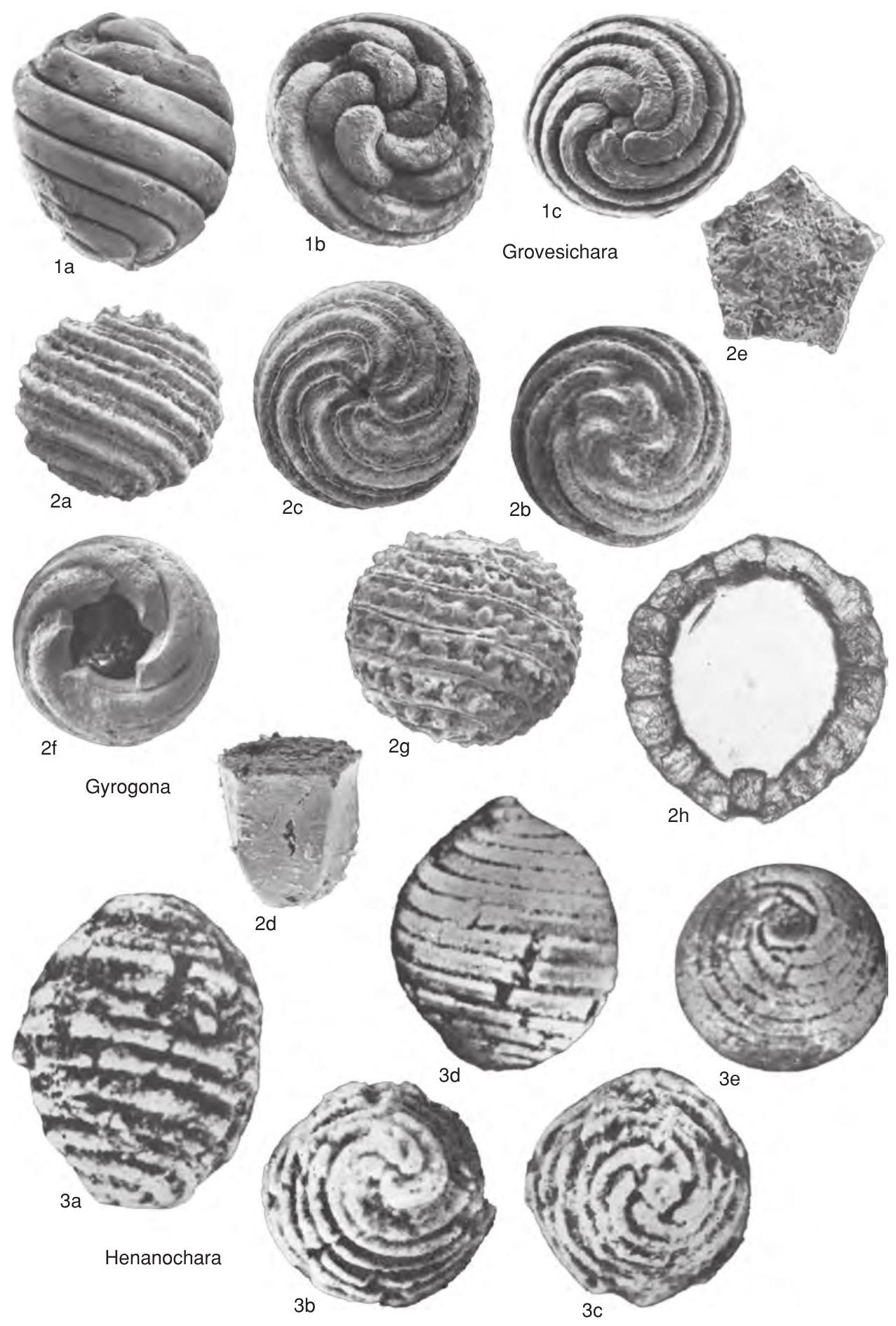Welcome to the Treatise on Invertebrate Paleontology!
Please enter a genera name to retrieve more information.

Gyrogona
Classification
Phylum:
Charophyta
Class:
Charophyceae
Order:
Charales
Suborder:
Charineae
Family:
Characeae
Subfamily:
Charoideae
Formal Genus Name and Reference:
Gyrogona Lamarck, 1822, p. 613, emend., GRAMBAST, 1956b, p. 280
Type Species:
Gyrogonites medicaginula LAMARCK, 1822, p. 614, OD, =Gyrogonites medicaginula LAMARCK, 1804, p. 356, nom. nud.
Images
(Click to enlarge in a new window)
Fig. 66,2a-c. * G. medicaginula Lamarck, Stampian, France, a, neotype, designated herein, lateral view, C.146-1, x25 (new), b, apical view, x25 (Grambast & Grambast-Fessard, 1981, pl. IV,12), c, basal view, C.146-8, x25 (new). Fig. 66,2d-f. G. lamarcki Grambast, middle Eocene, France, d, basal plate, lateral view, x100, e, basal plate, upper side, x100, f, apical opening, x20 (Grambast & Grambast-Fessard, 1981, pl. I, 11, 10, 7)._Fig. 66,2g. G. caelata (Reid & Groves) Grambast, middle Eocene, France, lateral view, x30 (Grambast & Grambast-Fessard, 1981, pl. IV, 1 ).—FIIG. 66,2h. G. lemani lemani (Brongniart) Pia, middle Eocene, France, longitudinal section, x40 (Grambast & Grambast-Fessard, 1981, pl. VI,2).
Synonyms
Gyrogonites, Brachychara,
Geographic Distribution
Belgium, France, Germany, United Kingdom, Spain, China, India, ?USA, China (Xinxiang), upper Miocene (LU & Luo, 1990).——FIG. 66,2a-c. * G. medicaginula Lamarck, Stampian, France, $a$, neotype, designated herein, lateral view, C.146-1, $\\times 25$ (new), $b$, apical view, $\\times 25$ (Grambast & Grambast-Fessard, 1981, pl. IV,12), $c$, basal view, C.146-8, $\\times 25$ (new). Fig. 66,2d-f. G. lamarcki Grambast, middle Eocene, France, $d$, basal plate, lateral view, $\\times 100, e$, basal plate, upper side, $\\times 100, f$, apical opening, $\\times 20$ (Grambast & Grambast-Fessard, 1981, pl. I, 11, 10, 7)._Fig. 66,2g. G. caelata (Reid & Groves) Grambast, middle Eocene, France, lateral view, $\\times 30$ (Grambast & Grambast-Fessard, 1981, pl. IV, 1 ).—FIIG. 66,2h. G. lemani lemani (Brongniart) Pia, middle Eocene, France, longitudinal section, $\\times 40$ (Grambast & Grambast-Fessard, 1981, pl. VI,2).
Age Range
Beginning Stage in Treatise Usage:
Paleogene (lower Eocene)
Beginning International Stage:
Ypresian
Fraction Up In Beginning Stage:
0
Beginning Date:
56
Ending Stage in Treatise Usage:
Neogene (upper Miocene)
Ending International Stage:
Messinian
Fraction Up In Ending Stage:
100
Ending Date:
5.34
Description
Apex nitellopsidoid, Deep periapical furrow without notable narrowing of spirals, surrounding prominent rosette of well-marked nodules, Gyrogonite oblate to oblate-spheroidal, Spirals smooth or variously ornamented, Base rounded, in some species, basal pore surrounded by widened funnel, Basal plate very thick, higher than wide, not visible from exterior, Size large. [Among the species reported by Z. WANG (1978a) from China, some, such as the Cretaceous G. hubeiensis, are more likely to be referable to Platychara.]
References
Museum or Author Information
Classification
Phylum:
Charophyta
Class:
Charophyceae
Order:
Charales
Suborder:
Charineae
Family:
Characeae
Subfamily:
Charoideae
Formal Genus Name and Reference:
Gyrogona Lamarck, 1822, p. 613, emend., GRAMBAST, 1956b, p. 280
Type Species:
Gyrogonites medicaginula LAMARCK, 1822, p. 614, OD, =Gyrogonites medicaginula LAMARCK, 1804, p. 356, nom. nud.
Images
(Click to enlarge in a new window)
Fig. 66,2a-c. * G. medicaginula Lamarck, Stampian, France, a, neotype, designated herein, lateral view, C.146-1, x25 (new), b, apical view, x25 (Grambast & Grambast-Fessard, 1981, pl. IV,12), c, basal view, C.146-8, x25 (new). Fig. 66,2d-f. G. lamarcki Grambast, middle Eocene, France, d, basal plate, lateral view, x100, e, basal plate, upper side, x100, f, apical opening, x20 (Grambast & Grambast-Fessard, 1981, pl. I, 11, 10, 7)._Fig. 66,2g. G. caelata (Reid & Groves) Grambast, middle Eocene, France, lateral view, x30 (Grambast & Grambast-Fessard, 1981, pl. IV, 1 ).—FIIG. 66,2h. G. lemani lemani (Brongniart) Pia, middle Eocene, France, longitudinal section, x40 (Grambast & Grambast-Fessard, 1981, pl. VI,2).
Synonyms
Gyrogonites, Brachychara,
Geographic Distribution
Belgium, France, Germany, United Kingdom, Spain, China, India, ?USA, China (Xinxiang), upper Miocene (LU & Luo, 1990).——FIG. 66,2a-c. * G. medicaginula Lamarck, Stampian, France, $a$, neotype, designated herein, lateral view, C.146-1, $\\times 25$ (new), $b$, apical view, $\\times 25$ (Grambast & Grambast-Fessard, 1981, pl. IV,12), $c$, basal view, C.146-8, $\\times 25$ (new). Fig. 66,2d-f. G. lamarcki Grambast, middle Eocene, France, $d$, basal plate, lateral view, $\\times 100, e$, basal plate, upper side, $\\times 100, f$, apical opening, $\\times 20$ (Grambast & Grambast-Fessard, 1981, pl. I, 11, 10, 7)._Fig. 66,2g. G. caelata (Reid & Groves) Grambast, middle Eocene, France, lateral view, $\\times 30$ (Grambast & Grambast-Fessard, 1981, pl. IV, 1 ).—FIIG. 66,2h. G. lemani lemani (Brongniart) Pia, middle Eocene, France, longitudinal section, $\\times 40$ (Grambast & Grambast-Fessard, 1981, pl. VI,2).
Age Range
Beginning Stage in Treatise Usage:
Paleogene (lower Eocene)
Beginning International Stage:
Ypresian
Fraction Up In Beginning Stage:
0
Beginning Date:
56
Ending Stage in Treatise Usage:
Neogene (upper Miocene)
Ending International Stage:
Messinian
Fraction Up In Ending Stage:
100
Ending Date:
5.34
Description
Apex nitellopsidoid, Deep periapical furrow without notable narrowing of spirals, surrounding prominent rosette of well-marked nodules, Gyrogonite oblate to oblate-spheroidal, Spirals smooth or variously ornamented, Base rounded, in some species, basal pore surrounded by widened funnel, Basal plate very thick, higher than wide, not visible from exterior, Size large. [Among the species reported by Z. WANG (1978a) from China, some, such as the Cretaceous G. hubeiensis, are more likely to be referable to Platychara.]
